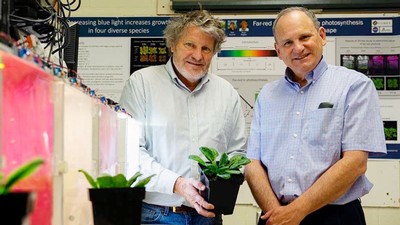In Response to COVID-19, SDL Satellite Operators "Fly" Small Sats from Home
The Space Dynamics Laboratory announced that satellite operators are flying NASA spacecraft from their homes to help prevent the spread of COVID-19. This August 2019 composite image illustrates NASA's Hyper-Angular Rainbow Polarimeter CubeSat that is currently being operated by SDL. (Credit: NASA/Space Dynamics Laboratory).
The Space Dynamics Laboratory at Utah State University announced that satellite operators are flying NASA spacecraft from their homes to help prevent the spread of COVID-19.
The emphasis on social distancing and stay-at-home work has become ubiquitous throughout the world and has affected sectors of many industries, including the space industry. In response to disruptions of normal work methods due to the global pandemic, SDL satellite operators have successfully shifted operations of two NASA small satellites away from traditional Mission Operations Centers to alternative flight centers—their living rooms.
“By leveraging government-approved secure network services and working within security and information assurance protocols, SDL has the ability to operate spacecraft effectively and securely from anywhere an internet connection exists,” said Tim Neilsen, program manager in SDL’s Commercial and Civil Space Division. “NASA’s Hyper-Angular Rainbow Polarimeter CubeSat and the Compact Infrared Radiometer in Space instrument small satellite, known as HARP and CIRiS respectively, are two science satellites that are now being commanded by SDL satellite operators outside of SDL facilities.”
Measuring approximately 10 centimeters wide, 10 centimeters high, and 30 centimeters long, the HARP satellite was built by SDL to carry the payload built by the University of Maryland, Baltimore County. The objective of HARP is to validate the in-flight capabilities of a highly accurate and precise wide field of view hyper-angular polarimeter for characterizing aerosol and cloud properties. Additionally, HARP will demonstrate that CubeSat-size technology can provide science-quality multi-angle imaging data, paving the way for lower-cost aerosol-cloud instrument development.
Built by Ball Aerospace, CIRiS is collecting, processing, and calibrating infrared images of Earth. The satellite, about the size of a backpack with a mass of approximately 25 pounds, is testing a small, space-based infrared instrument that collects images to be used for a variety of scientific studies, including studies of cloud properties and mapping of soil moisture for measuring local drought conditions.
“We have worked closely with NASA and the principal investigators for HARP and CIRiS to ensure their mission objectives are being met while our employees are practicing recommended COVID-19 mitigation methods,” said Asal Naseri, SDL’s small satellite technologies branch head. “The health and safety of our employees is a top priority for SDL, and we are actively pursuing opportunities for them to work from home during this extraordinary time while maintaining commitments to our partners.”
SDL has been solving the technical challenges faced by the military, science community, and industry for six decades and supports NASA’s vision to reveal the unknown for the benefit of humankind. As one of 14 University Affiliated Research Centers, SDL serves as a subject matter expert in its core research areas to the US Government, ensuring that essential engineering and technology capabilities are maintained. SDL is a research laboratory headquartered in North Logan, UT, and has offices in Albuquerque, NM; Bedford, MA; Dayton, OH; Huntsville, AL; Houston, TX; Los Angeles, CA; Stafford, VA; and Washington, DC. For more information, visit www.sdl.usu.edu.
CONTACT
Eric Warren
Director, Public Relations
Space Dynamics Laboratory
435-881-8439
eric.warren@sdl.usu.edu
TOPICS
COVID-19 157stories Space 140stories SDL 89stories NASA 83stories Satellites 67storiesComments and questions regarding this article may be directed to the contact person listed on this page.







